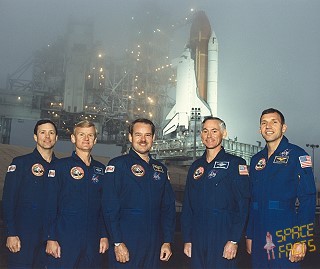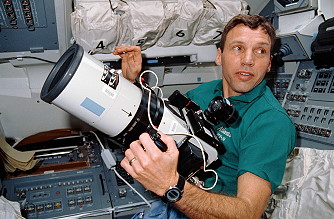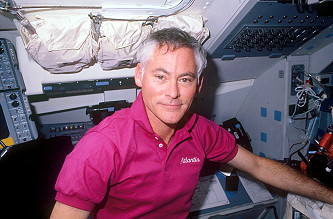Human Orbital Spaceflights
![]()
International Flight No. 129STS-36Atlantis (6)34th Space Shuttle missionUSA |
 |
 |
![]()
Launch, orbit and landing data
walkout photo |
 |
||||||||||||||||||||||||||||
alternative crew photo |
|||||||||||||||||||||||||||||
alternative crew photo |
Crew
| No. | Surname | Given names | Position | Flight No. | Duration | Orbits | |
| 1 | Creighton | John Oliver | CDR | 2 | 4d 10h 18m 22s | 72 | |
| 2 | Casper | John Howard | PLT | 1 | 4d 10h 18m 22s | 72 | |
| 3 | Mullane | Richard Michael | MS-1 | 3 | 4d 10h 18m 22s | 72 | |
| 4 | Hilmers | David Carl | MS-2, EV-1, FE | 3 | 4d 10h 18m 22s | 72 | |
| 5 | Thuot | Pierre Joseph | MS-3, EV-2 | 1 | 4d 10h 18m 22s | 72 |
Crew seating arrangement
|
 |
|
||||||||||||||||||||||||
Hardware
| Orbiter : | OV-104 (6.) |
| SSME (1 / 2 / 3): | 2019 (6.) / 2030 (4.) / 2027 (4.) |
| SRB: | BI-036 / RSRM 9 |
| ET: | ET-36 (LWT-26) |
| OMS Pod: | Left Pod 01 (12.) / Right Pod 03 (11.) |
| FWD RCS Pod: | FRC 4 (6.) |
| RMS: | - |
| EMU: | EMU No. 2006 (PLSS No. 1014) / EMU No. 2008 (PLSS No. 1011) |
Flight
|
Launch from Cape Canaveral (KSC) and
landing on the Edwards
AFB, Runway
23. The launch was originally set for February 22, 1990, and was postponed for three times due to illness of the crew commander and weather conditions. This was the first time since Apollo 13 in 1970 that a manned space mission was affected by illness of a crew member. The launch attempt was then set for February 25, 1990 and was scrubbed due to malfunction of a range safety computer. The February 26, 1990 attempt was scrubbed due to weather conditions. The launch trajectory was unique to this flight, and allowed the mission to reach an orbital inclination of 62°, the deployment orbit of its payload - the normal maximum inclination for a shuttle flight was 57°. This so-called "dog-leg" trajectory saw Atlantis fly downrange on a normal launch azimuth, and then maneuver to a higher launch azimuth once out over the water. Although the maneuver resulted in a reduction of vehicle performance, it was the only way to reach the required deployment orbit from Kennedy Space Center (originally, the flight had been slated to launch from Vandenberg Air Force Base in California, until the shuttle launch facilities there were mothballed in 1989). Flight rules that prohibited overflight of land were suspended, with the trajectory taking the vehicle over or near Cape Hatteras, Cape Cod, and parts of Canada. The payload was considered to be of importance to national security, hence the suspension of normal flight rules. This flight was the sixth mission dedicated to the Department of Defense, and most information about it remained classified. For the sixth time, NASA did not provide pre-launch commentary to the public until nine minutes before liftoff. It was the fourth military mission without a MSE among the crew members. Main goal was the deployment of the reconnaissance satellite AFP-731 (KH-12; USA-53), using an all-digital imaging system to return pictures. KH-11 satellites are believed to resemble the Hubble Space Telescope in size and shape, as the satellites were shipped in similar containers, and had comparable primary mirror diameters. USA-53, nicknamed "Misty", was tracked briefly by amateur satellite observers in October and November 1990. Assuming a 2.4-meter mirror, the theoretical ground resolution with no atmospheric degradation and 50% MTF would be roughly 15 cm (6 inches). Operational resolution would be worse due to effects of the atmosphere. Different versions of the KH-11 vary in mass, with earlier blocks ranging from 13,000 to 13,500 kilograms, whilst later blocks have a mass of around 19,600 kg. Its length is believed to be 19.5 meters, and diameter is 3 meters or less. The two optical telescope assemblies (OTAs only, not full satellites) offered to NASA from the NRO in January 2011 are suspected, but not confirmed, to be KH-11 series "extra hardware". The OTA's are of a three-mirror anastigmat (TMA) optical design (sans the 3rd "tertiary" mirror). The f/1.2 primary has a diameter of 2.4 m, and is refocused by the secondary to give an overall f/8 focal ratio, making the optical telescope assembly shorter than that of HST. With the addition of the tertiary mirror, this will produce a much wider field than Hubble's 2-mirror f/24 Ritchey–Chrétien optical design, making it a potentially ideal observatory for Dark Energy or other astrophysics surveys. The secondary mirror is mounted on a hexapod to increase the side-viewing and ground scanning ability for the originally intended reconnaissance mission. KH-11 was the first reconnaissance satellite equipped with charge-coupled device (CCD) array technology for imaging which had a resolution of 800 x 800 pixels. About 62 dents in the shuttle's Thermal Protection System tiles were counted by the debris team after the mission. Tile engineers reported that only one tile required replacement. The brakes and tires performed nominally. Drops of hydraulic fluid were observed in the right main landing gear wheel well, the liquid hydrogen 17-inch (430 mm) disconnect cavity and possibly around two of the main engines. |
Photos / Graphics
 |
 |
 |
 |
 |
 |
 |
 |
 |
 |
 |
 |
Earth observation photos |
|
| © |  |
Last update on March 31, 2020.  |
 |